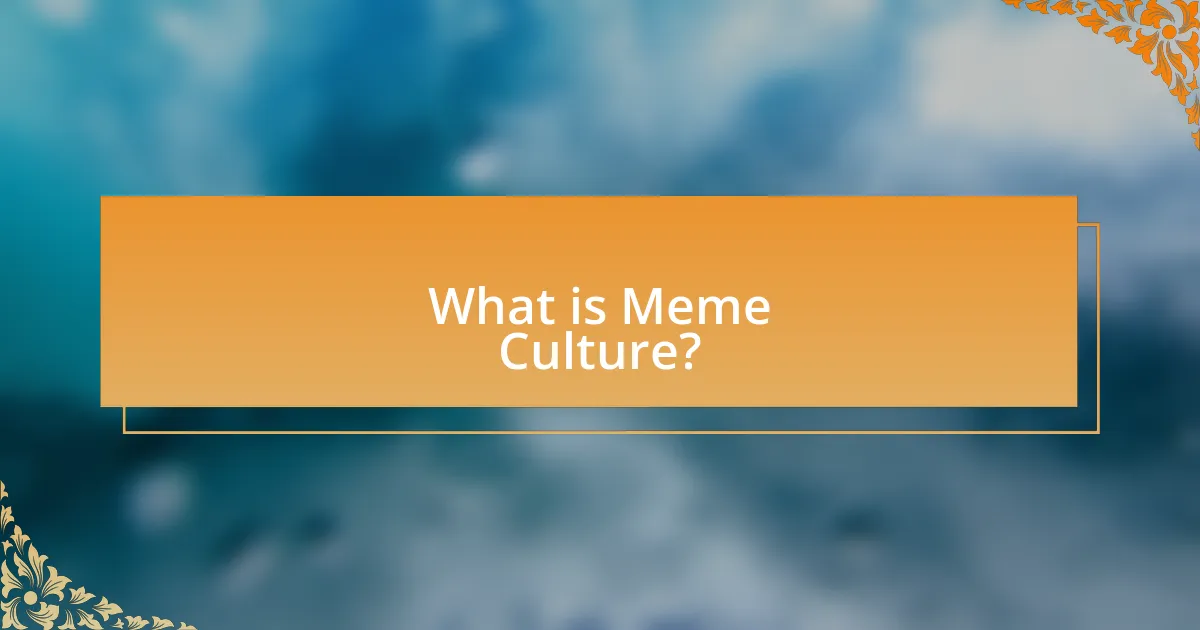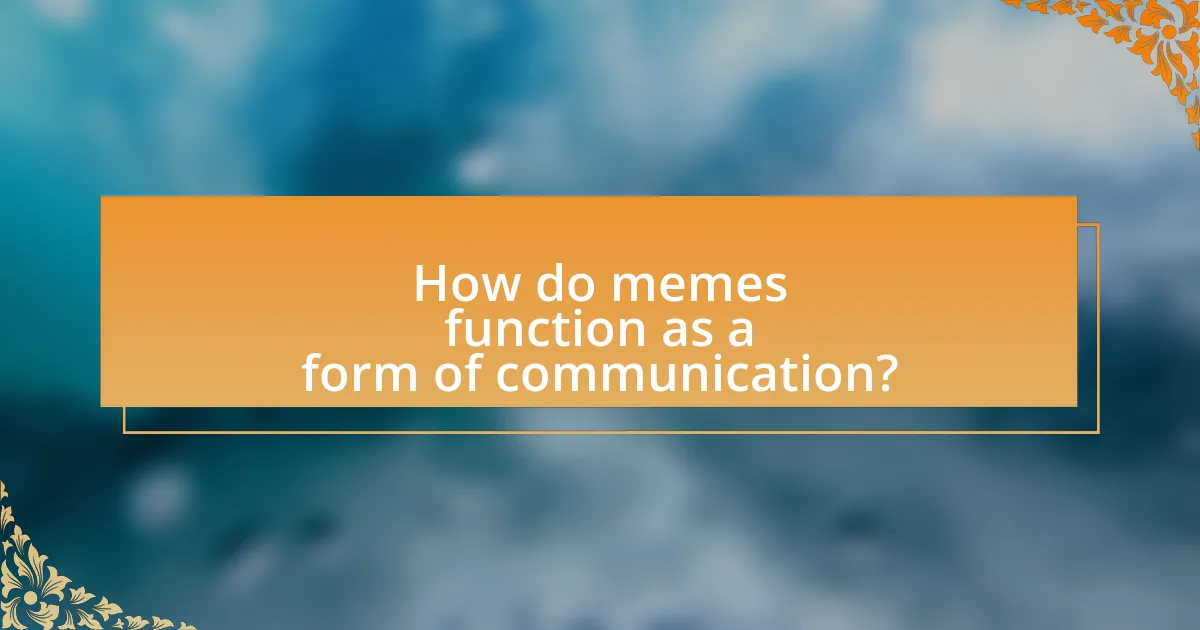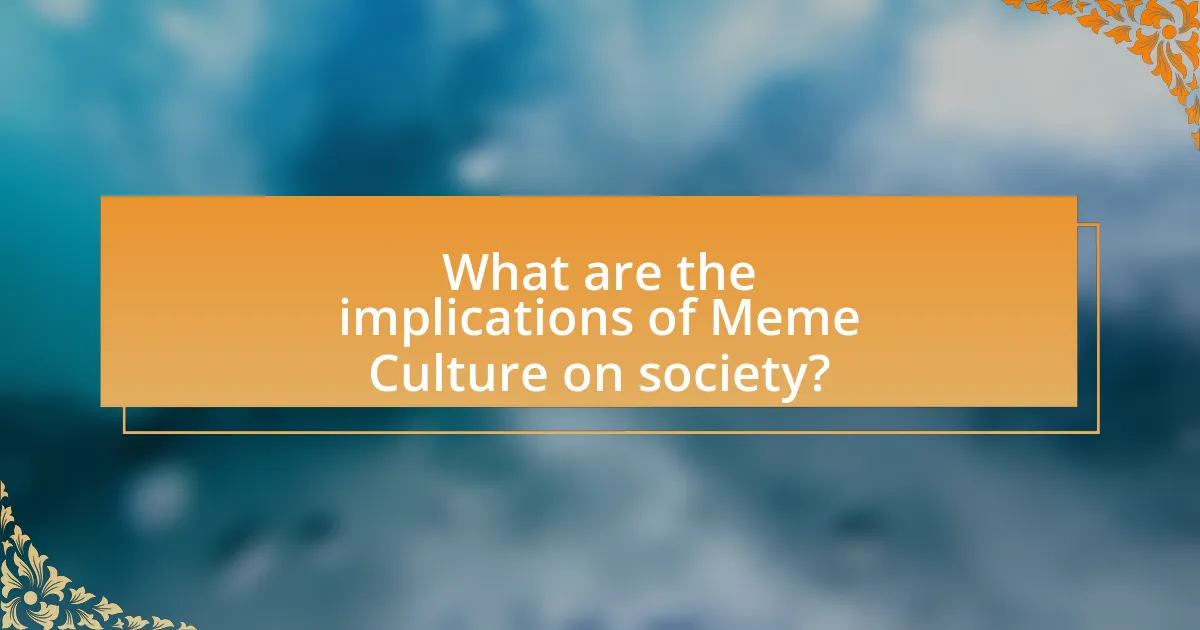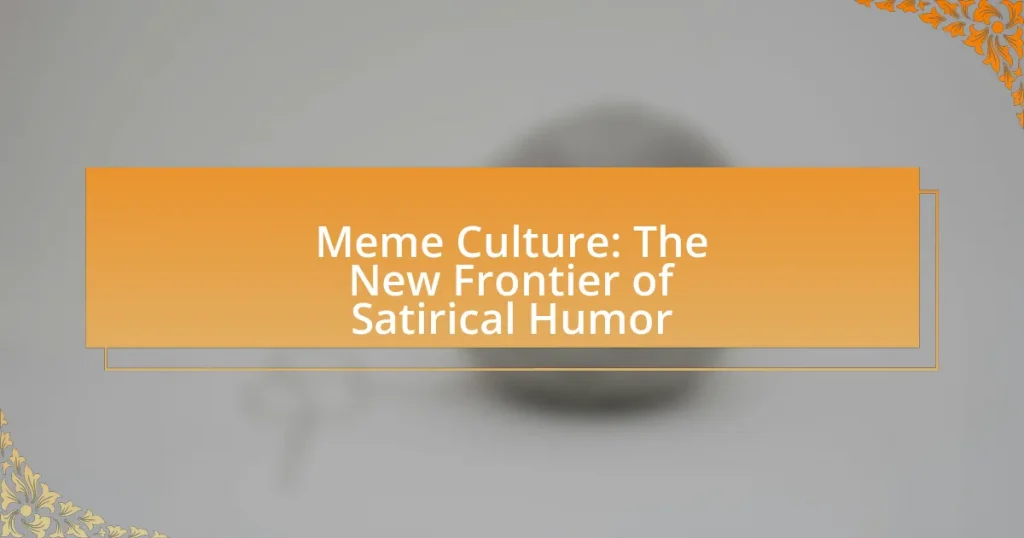Meme culture is a social phenomenon that involves the rapid creation, sharing, and evolution of humorous content, primarily through social media platforms. This article explores the emergence of meme culture in the digital age, highlighting key historical milestones and the influence of technology on its evolution. It examines how memes reflect societal trends and issues, their role in contemporary satire, and their impact on public opinion and discourse. Additionally, the article addresses the potential downsides of meme culture, including misinformation and harmful stereotypes, while providing practical tips for engaging with this dynamic form of communication responsibly.

What is Meme Culture?
Meme culture is a social phenomenon characterized by the rapid creation, sharing, and evolution of humorous images, videos, and text that often reflect cultural references and societal trends. This culture thrives on platforms like social media, where users engage in remixing and repurposing content, leading to viral trends. The significance of meme culture lies in its ability to convey complex ideas and emotions succinctly, often using irony or satire, which resonates with a wide audience. For instance, the “Distracted Boyfriend” meme illustrates how a simple image can encapsulate relatable human experiences, demonstrating the power of visual humor in contemporary communication.
How did Meme Culture emerge in the digital age?
Meme culture emerged in the digital age primarily through the rapid proliferation of internet access and social media platforms, which facilitated the sharing and remixing of content. The advent of platforms like Reddit, 4chan, and later Instagram and TikTok allowed users to create, share, and adapt humorous images, videos, and phrases, often reflecting current events or cultural phenomena. This phenomenon was further accelerated by the viral nature of content on these platforms, where memes could reach a global audience within hours. Research indicates that the first widely recognized meme, the “Dancing Baby,” appeared in 1996, showcasing early digital humor’s potential for virality. As technology evolved, so did the complexity and variety of memes, leading to a diverse landscape that includes formats like image macros, GIFs, and video memes, all contributing to the rich tapestry of contemporary satirical humor.
What are the historical milestones that shaped Meme Culture?
The historical milestones that shaped Meme Culture include the emergence of the internet in the 1990s, the creation of the first meme, “Dancing Baby,” in 1996, and the rise of social media platforms like Reddit and Facebook in the 2000s. The internet’s expansion allowed for rapid sharing and remixing of content, which was exemplified by the viral spread of “Dancing Baby,” one of the earliest examples of a meme. Additionally, the introduction of image macros, particularly the “LOLcats” phenomenon in the mid-2000s, further popularized meme culture by combining images with humorous text. The launch of platforms like 4chan in 2003 and the subsequent development of meme formats such as “Rickrolling” and “Pepe the Frog” in the 2010s solidified memes as a significant aspect of online communication and humor. These milestones collectively contributed to the evolution and mainstream acceptance of meme culture as a form of satirical expression.
How has technology influenced the evolution of memes?
Technology has significantly influenced the evolution of memes by enabling rapid creation, sharing, and adaptation across various digital platforms. The rise of social media platforms like Facebook, Twitter, and Instagram has facilitated instantaneous dissemination of memes, allowing them to reach global audiences within minutes. Additionally, advancements in mobile technology and internet accessibility have empowered users to create and remix memes easily, leading to diverse variations and cultural adaptations. For instance, the introduction of meme-generating websites and apps has simplified the process, allowing even those with minimal technical skills to participate in meme culture. This democratization of content creation has resulted in a dynamic and ever-evolving landscape of memes that reflect current events, social issues, and cultural trends.
What defines Meme Culture today?
Meme culture today is defined by its rapid dissemination of humor and commentary through visual content, primarily on social media platforms. This culture thrives on relatability, often using irony and absurdity to engage audiences, as seen in the popularity of formats like reaction images and viral challenges. The prevalence of memes is supported by statistics indicating that over 55% of internet users engage with memes regularly, highlighting their role in shaping online communication and social discourse.
What are the key characteristics of modern memes?
Modern memes are characterized by their rapid dissemination, relatability, and adaptability. They often utilize humor, irony, and cultural references to convey messages succinctly. The format of modern memes typically includes images or videos paired with text, allowing for easy sharing across social media platforms. Additionally, modern memes frequently evolve through remixing and user-generated content, reflecting current events and trends. This adaptability is supported by the fact that platforms like Twitter and Instagram facilitate viral sharing, enabling memes to reach wide audiences quickly.
How do memes reflect societal trends and issues?
Memes reflect societal trends and issues by serving as a visual and textual commentary on contemporary events, cultural phenomena, and social norms. They encapsulate public sentiment, often highlighting collective frustrations, humor, or absurdities related to politics, technology, and social justice. For instance, during the COVID-19 pandemic, memes proliferated that addressed themes of isolation, health guidelines, and the absurdity of certain government responses, illustrating how humor can emerge from shared experiences of crisis. Additionally, research by the Pew Research Center indicates that 55% of U.S. adults have seen memes related to political issues, demonstrating their role in shaping and reflecting public discourse. Thus, memes act as a barometer for societal attitudes, effectively communicating complex ideas in an accessible format.
Why is Meme Culture considered a new frontier of satirical humor?
Meme culture is considered a new frontier of satirical humor because it democratizes the creation and dissemination of comedic content, allowing anyone with internet access to participate. This shift has led to rapid and widespread sharing of humor that often critiques societal norms, politics, and pop culture, making satire more accessible and relatable. For instance, the viral nature of memes enables them to reach diverse audiences quickly, as seen with the “Distracted Boyfriend” meme, which has been used to comment on various social issues, illustrating how humor can adapt to current events. This adaptability and immediacy distinguish meme culture from traditional forms of satire, which often require more time and resources to produce and distribute.
What role do memes play in contemporary satire?
Memes serve as a crucial vehicle for contemporary satire by enabling rapid dissemination of humor and critique through visual and textual formats. They encapsulate complex social and political commentary in easily shareable and relatable content, allowing for widespread engagement and discussion. For instance, memes often utilize irony and exaggeration to highlight societal issues, as seen in the viral “Distracted Boyfriend” meme, which critiques infidelity and societal expectations. This format not only entertains but also fosters critical thinking and dialogue among audiences, making memes a powerful tool in the landscape of modern satire.
How do memes differ from traditional forms of humor?
Memes differ from traditional forms of humor primarily in their rapid dissemination and adaptability through digital platforms. Unlike traditional humor, which often relies on structured formats like stand-up comedy or scripted television, memes leverage visual elements and concise text to convey humor quickly and effectively. This format allows for immediate sharing and remixing, enabling users to create variations that reflect current events or cultural trends. For instance, the viral nature of memes on social media platforms like Twitter and Instagram facilitates a broader reach and engagement compared to traditional humor, which is typically confined to specific audiences or mediums.

How do memes function as a form of communication?
Memes function as a form of communication by conveying complex ideas, emotions, and cultural references through visual and textual elements. They utilize humor, irony, and relatability to engage audiences, allowing for rapid sharing and interpretation across social media platforms. Research indicates that memes can encapsulate social commentary and collective sentiments, making them effective tools for expressing opinions and fostering community identity. For instance, a study by Shifman (2014) in “Memes in Digital Culture” highlights how memes serve as a medium for political discourse, enabling users to communicate nuanced messages succinctly and effectively.
What are the mechanisms behind meme creation and sharing?
Meme creation and sharing primarily occur through social media platforms, where users generate content that resonates with cultural trends or humor. The mechanisms involve the use of relatable images, text, and formats that can be easily modified and disseminated. For instance, platforms like Twitter, Instagram, and TikTok facilitate rapid sharing and remixing of memes, allowing them to spread virally. Research indicates that memes often leverage existing cultural references, making them more relatable and shareable; a study by Shifman (2014) highlights how memes function as a form of social commentary, enhancing their appeal and engagement. Additionally, the participatory nature of online communities encourages users to contribute their variations, further amplifying the meme’s reach and impact.
How do users engage with and remix memes?
Users engage with and remix memes by creating variations that reflect personal experiences, cultural references, or current events. This engagement often involves altering images, text, or formats to convey new meanings or humor, which fosters community interaction and creativity. For instance, platforms like Reddit and Instagram facilitate this by allowing users to share and modify existing memes, leading to viral trends. Research indicates that 55% of internet users have participated in meme creation, highlighting the widespread nature of this engagement.
What platforms are most influential in meme dissemination?
Social media platforms such as Instagram, Twitter, TikTok, and Reddit are the most influential in meme dissemination. These platforms facilitate rapid sharing and engagement, allowing memes to reach vast audiences quickly. For instance, TikTok’s algorithm promotes viral content, enabling memes to spread widely within hours. Similarly, Reddit’s community-driven structure allows for niche meme sharing, fostering diverse meme cultures. Instagram’s visual focus enhances meme appeal, while Twitter’s real-time nature supports quick reactions and retweets, amplifying meme visibility. Collectively, these platforms shape the landscape of meme culture, driving trends and influencing public discourse.
How do memes convey complex ideas and emotions?
Memes convey complex ideas and emotions through visual imagery combined with concise text, allowing for rapid communication of nuanced concepts. This combination enables users to express feelings, social commentary, or cultural critiques in a format that is easily digestible and shareable. For instance, the use of popular cultural references in memes can evoke specific emotions or reactions, as seen in the “Distracted Boyfriend” meme, which illustrates the conflict between desire and commitment, resonating with audiences on multiple levels. The effectiveness of memes in conveying these ideas is supported by their widespread use in social media, where they often go viral, indicating their ability to connect with a broad audience and encapsulate complex sentiments succinctly.
What techniques do meme creators use to enhance relatability?
Meme creators enhance relatability by utilizing techniques such as humor, cultural references, and shared experiences. Humor allows creators to connect with audiences through laughter, making the content more engaging. Cultural references tap into widely recognized events, trends, or figures, which resonate with viewers and create a sense of familiarity. Shared experiences, often drawn from everyday life, enable audiences to see themselves in the meme, fostering a personal connection. For instance, memes about common struggles, like procrastination or awkward social interactions, are relatable because they reflect universal feelings and situations. These techniques are effective because they leverage the collective consciousness of the audience, making the content more impactful and shareable.
How do visual elements contribute to the effectiveness of memes?
Visual elements significantly enhance the effectiveness of memes by providing immediate context and emotional resonance. Memes often rely on images, colors, and typography to convey humor or commentary quickly, allowing viewers to grasp the intended message at a glance. For instance, a well-chosen image can evoke specific emotions or associations, making the meme more relatable and shareable. Research indicates that visual stimuli are processed 60,000 times faster than text, underscoring the importance of visuals in capturing attention and facilitating understanding. This rapid processing contributes to the viral nature of memes, as engaging visuals encourage sharing and interaction across social media platforms.

What are the implications of Meme Culture on society?
Meme culture significantly influences society by shaping communication, social norms, and political discourse. It facilitates rapid information dissemination, allowing ideas to spread quickly across diverse demographics, which can lead to increased awareness of social issues. For instance, memes have been used effectively in movements like Black Lives Matter, where visual content mobilizes support and raises awareness. Additionally, meme culture often blurs the lines between humor and serious commentary, enabling discussions on sensitive topics in a more approachable manner. This duality can foster community and solidarity among individuals who share similar views, while also provoking backlash and polarization among opposing groups. The pervasive nature of memes in digital communication underscores their role in contemporary societal dynamics, reflecting and sometimes shaping public opinion.
How do memes influence public opinion and discourse?
Memes significantly influence public opinion and discourse by shaping perceptions and facilitating the rapid spread of ideas. They serve as a form of social commentary, often simplifying complex issues into relatable and shareable content, which can sway public sentiment. For instance, during political campaigns, memes can amplify messages, create narratives, and mobilize support or opposition, as evidenced by the viral spread of memes during the 2016 U.S. presidential election, which played a crucial role in shaping voter perceptions and engagement. Research indicates that memes can reinforce existing beliefs and biases, as they often resonate with specific audiences, thereby impacting collective attitudes and discussions in society.
What examples illustrate memes impacting political movements?
Memes have significantly impacted political movements, with notable examples including the 2016 U.S. presidential election and the Arab Spring. During the 2016 election, memes such as “Pepe the Frog” were used extensively to convey political messages, influencing voter perceptions and engagement, particularly among younger demographics. The Arab Spring saw the widespread use of memes on social media platforms to mobilize protests and disseminate information, exemplified by the “We Are All Khaled Said” meme, which galvanized support for the movement against authoritarian regimes in Egypt. These instances demonstrate how memes can shape political discourse and mobilize collective action.
How do memes shape cultural narratives and identities?
Memes shape cultural narratives and identities by serving as a medium for collective expression and social commentary. They encapsulate shared experiences, beliefs, and humor, allowing individuals to connect over common themes. For instance, the viral meme “Distracted Boyfriend” illustrates societal attitudes towards relationships and infidelity, reflecting cultural norms and expectations. Research indicates that memes can influence public opinion and identity formation, as seen in the 2016 U.S. presidential election, where memes played a significant role in shaping political discourse and voter perceptions. This demonstrates that memes not only entertain but also actively participate in the construction of cultural narratives and identities.
What are the potential downsides of Meme Culture?
The potential downsides of meme culture include the spread of misinformation, the trivialization of serious issues, and the reinforcement of harmful stereotypes. Misinformation can proliferate rapidly through memes, as they often simplify complex topics, leading to misunderstandings; for instance, a study by the MIT Media Lab found that false news spreads six times faster than true news on social media platforms. Additionally, memes can trivialize significant social or political issues, reducing them to jokes that may undermine their importance. Lastly, memes can perpetuate harmful stereotypes, as they frequently rely on exaggeration and caricature, which can reinforce negative perceptions about certain groups.
How can memes perpetuate misinformation or harmful stereotypes?
Memes can perpetuate misinformation or harmful stereotypes by simplifying complex issues into easily digestible images or phrases that often lack context. This oversimplification can lead to the spread of false narratives, as seen in the viral meme “Distracted Boyfriend,” which has been used to misrepresent various social issues by altering the labels without providing accurate context. Research indicates that memes can influence public perception and reinforce existing biases, as they often rely on humor and relatability, making them more shareable and persuasive. A study published in the journal “Computers in Human Behavior” found that memes can significantly shape attitudes and beliefs, particularly among younger audiences who may not critically evaluate the content.
What ethical considerations arise from meme sharing?
Meme sharing raises several ethical considerations, primarily concerning copyright infringement, misinformation, and the potential for harm. Copyright infringement occurs when memes use copyrighted images or content without permission, violating intellectual property rights. Misinformation can spread rapidly through memes, as they often simplify complex issues, leading to misunderstandings or false narratives. Additionally, memes can perpetuate stereotypes or promote hate speech, causing emotional or psychological harm to individuals or groups. These ethical concerns highlight the need for responsible sharing practices within meme culture.
What practical tips can enhance engagement with Meme Culture?
To enhance engagement with Meme Culture, individuals should actively participate in meme creation and sharing across social media platforms. Engaging with trending topics and utilizing popular formats increases visibility and relatability, as evidenced by the rapid spread of memes during significant events like the COVID-19 pandemic, where memes served as a coping mechanism and a means of communication. Additionally, collaborating with influencers who resonate with meme culture can amplify reach, as seen with brands that successfully partnered with meme creators to engage younger audiences.
How can individuals create effective and relatable memes?
Individuals can create effective and relatable memes by understanding their target audience and using humor that resonates with shared experiences. This involves selecting popular cultural references, utilizing simple and clear visuals, and incorporating relatable text that captures common feelings or situations. Research indicates that memes that evoke strong emotional responses, such as laughter or nostalgia, are more likely to be shared and appreciated, as demonstrated by a study published in the journal “Computers in Human Behavior,” which found that humor significantly increases engagement on social media platforms.
What strategies can be used to navigate the complexities of Meme Culture responsibly?
To navigate the complexities of Meme Culture responsibly, individuals should prioritize critical thinking and context awareness. Critical thinking enables users to analyze the intent and implications of memes, distinguishing between humor and harmful stereotypes. Context awareness involves understanding the cultural and social backgrounds of memes, which can prevent the spread of misinformation and offensive content. For instance, a study by the Pew Research Center found that 64% of Americans believe that memes can contribute to misunderstandings about social issues, highlighting the need for responsible engagement. By applying these strategies, individuals can participate in Meme Culture while minimizing negative impacts.



